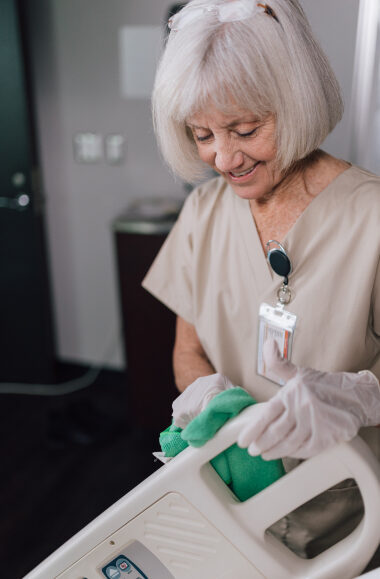COVID-19 Resources
These are unprecedented times. We're here to help.
Crothall and Compass One Healthcare responded to COVID-19 with new products, new protocols and new ideas but COVID-19 was not the first coronavirus and may not be the last. Make sure you’re ready for what’s to come.

Environmental Services
-
Extend the life of PPE with surfacide UV-C
Stretch critical resources like masks by using Surfacide UV-C machines. Masks should be grouped and marked in such a way so that they are returned to the original user, safely bagged and transported to a room inside the hospital which is equipped with 3 ultraviolet light towers.
-
Redeploy associates to support EVS
Some support service functions may experience lower volumes of work during the COVID-19 crisis. To keep up with a higher demand for cleaning, consider temporarily redeploying associates from other departments after receiving training to support EVS. We’re all better together.
-
Perception of clean
Many patients’ healthcare experiences are scarier than normal as hospitals are forced to limit families from entering their facilities. The perception of a clean healing environment can be comforting to patients who are having to go through treatment alone. Use signs within your hospital and digital communications (social media, website, patient portal, etc.) to tell patients what you’re doing to keep them safe if and when they do arrive.
-
Focus cleaning efforts to critical areas
During a pandemic it can be tempting to clean all areas with equal vigor. However, with many hospitals experiencing limited staffing and financial resources, focusing deep healthcare-grade cleaning to the most critical and highly trafficked areas is advised.
Facilities Management (FM)
-
Convert to Airborne Isolate Rooms
The rate at which the coronavirus is spreading differs by city and state, but all hospitals should have a plan to convert regular patient rooms to negative pressure rooms. Be sure to explore other spaces that can be converted for COVID-patient care. With stringent restrictions on guest entry, some hospitals have transformed lobbies into airborne isolated rooms. These adjustments also benefit hospital staff who feel more secure once these adjustments are made.
-
Regular Meetings With Local and Federal Agencies
As the epicenter of the virus shifts to different cities throughout the country pop up hospitals and medical tents will be crucial for treating patients. Getting these alternative medical sites up and running is made possible through strong relationships and regular communication with local and federal agencies. Set up regular meetings with local and national officials to streamline communication and decision-making processes. Need help? Reach out to us to learn how we helped hospitals in New York.
-
Staffing Contingencies
Develop a staffing contingency plan in case your FM department needs to operate with fewer people. Include guidelines for preventive and corrective work order management, and a guide to reducing staff in 25% increments. Make sure it covers the potential to supplement FM staff with vendors or temp agencies.
-
Split Management Teams
For prolonged crises like COVID-19, hospitals cannot afford to lose an entire management team within any department due to exposure. Split management teams into A & B groups: while one group is “on shift” at the hospital, the “off shift” group can work remotely to handle admin tasks. Splitting teams can prevent a whole department from being exposed at the same time and ensures 24/7 support also.
-
Oxygen Supply Systems
COVID-19 is placing enormous demands on healthcare facility’s oxygen supply systems. The current treatment process heavily taxes both the bulk and cylinder supply. Ensuring your hospital’s systems are in the best operating condition is crucial to getting through these days. Reach out to your vendors and supplier to ensure you’re prepared.
-
Postpone All Non-critical Projects
Many construction projects can and should be postponed during a crisis. Staff previously managing those projects can redeploy to Facilities Management to help build up needed headcount to support a 24/7 operation.
Patient Transportation (PT)
-
Bolster Patient Observation Services
Some high-risk patients require supervision 24/7. During a pandemic, hospitals and their support services teams should do everything possible to relive nurses from observation duty so they can treat others who are sick. Shift some patient transportation staff to patient observation to look after high-risk and COVID-positive patients.
-
Redeploy Staff to Support Nursing
Under normal circumstances, when patients arrive at a hospital’s front entrance, patient transporters move them from their car to inside the hospital. To limit exposure, redeploy transporters who typically provide curb-side service to help elsewhere. Transporters can help nurses with patient temperature checks, documenting information, or other tasks the caregivers need.
-
Establish PPE Command Centers
Hospital medical staff and patient transportation teams can work together to set up PPE command centers. A command center, or one central location where all PPE is collected and distributed prevents inefficient use of precious PPE. When someone requests additional PPE, patient transporters can deliver it throughout the hospital, and because their job requires them to know the most efficient routes, they’re a perfect candidate to quickly get PPE to whoever needs it.
Clinical Engineering & Healthcare Technology Solutions
-
Include Clinical Engineering in Existing Task Forces
Make sure a representative from your hospital’s clinical engineering team is included on the appropriate COVID-19 task forces. As COVID-19 continues to impact equipment availability, including ventilators, your hospital’s clinical engineers can provide critical information about new equipment, deployment and maintenance.
-
Tracking Covid Equipment
Utilize Crothall’s Team Trace computer maintenance management system (CMMS) to identify and track equipment designated for COVID-only use. Special COVID-only coding in Team Trace can help your hospital easily track COVID inventory and make important decisions quickly as your hospital’s equipment needs change.
-
Equipment Cleanliness and Disinfection Policy
Ensure all equipment coming into biomedical engineering workshops and storage areas is disinfected and cleaned on arrival and segregated in the designated shop clean equipment area.
-
Daily Reporting
As the situation evolves quickly and with varying degrees of severity across the country, daily reports can help hospital leaders keep tabs on what equipment is available, where it’s located, and what might need to be rented to make up the difference.
Communication plan
Be sure to address these three groups of people as your organization makes COVID-related decisions.
Patients & customers
Keep communication channels open with patients and customers open by relating important updates through signage, patient portal or digital communications.
Healthcare professionals
Offer daily infection control and medical-related updates for department leadership to cascade to staff. Record updates and post to your intranet.
Support services staff
Schedule recurring virtual staff meetings or huddles. Involve system leadership and context experts to develop an action plan, share best practices and updates. Also use this time to debunk any rumors that may have popped up to ease anxiety.
COVID-19 Resources
Let’s Talk About the Right Solution for Your Organization
Get in touch to discuss how Crothall Healthcare’s services and solutions can help your healthcare organization exceed its goals. You’ll learn more about:
- The transparency we bring to outsourced support services
- How we design customized solutions for your unique needs
- The technology and innovation Crothall delivers across all our services



